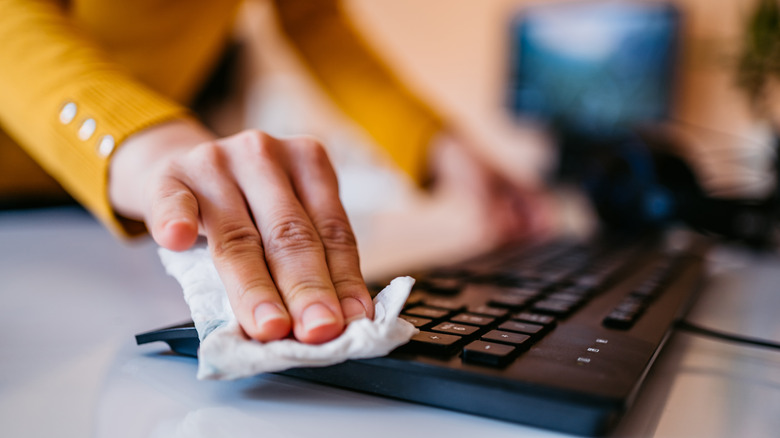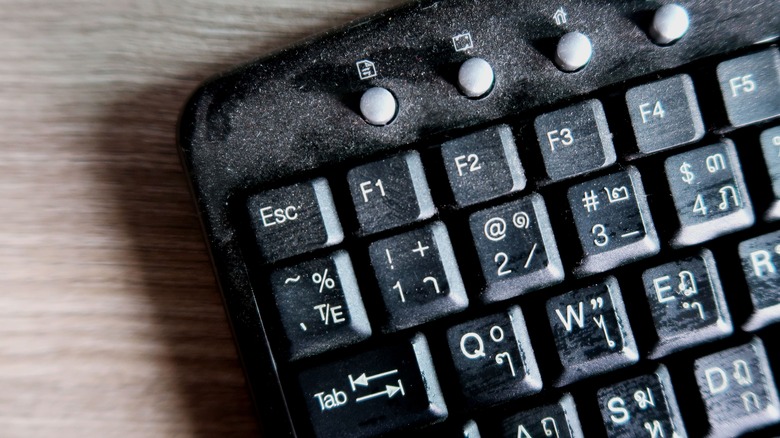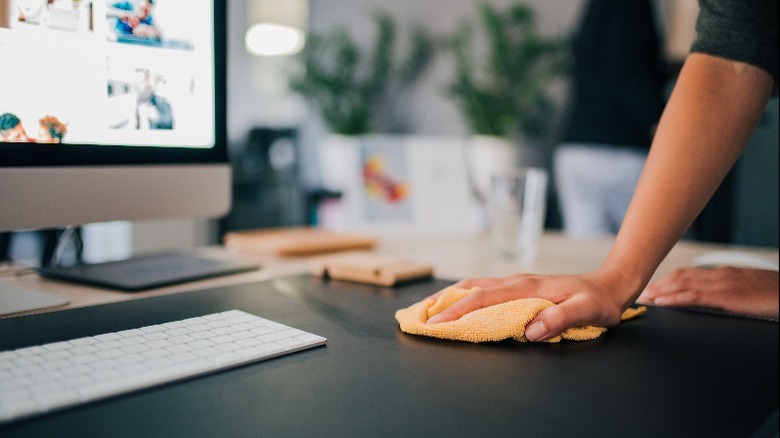Why You'll Want A Bottle Of Vinegar On Hand If You Have A Computer At Home
Have you ever looked at the keyboard on your laptop or desktop? Take a closer look, and you may see built-up dust, oils from your fingers, and who-knows-what on the edge. Cleaning a computer keyboard doesn't sound easy, especially since water and technology don't mix well. However, if you have a bottle of plain vinegar in your home, you may have exactly what you need to clean and spiffy up your peripheral in no time. Vinegar, along with a soft cloth or a cotton swab, is all you really need to clean the keyboard's surface and create a like-new device — or at least remove all the crumbs from the crackers you were eating.
Keyboards are prone to becoming dirty, especially if you use a mechanical keyboard with elevated keys. Dust, dander, and other debris in the air can easily land on the surface of the device, and that, along with any substances on your fingers and hands, those sticky kid fingerprints, and that bit of coffee spilled, can all lead to a dirty surface. Not removing this build-up could cause the keys to become stiff over time, and eventually get stuck.
When cleaning a keyboard, you'll want to avoid using any type of spray. It's also wise to take a few minutes to read the owner's manual to find out if there are any recommendations for properly cleaning the surface of the peripheral. Most often, careful application of a vinegar solution will do the trick.
How to use vinegar to clean a computer keyboard
Use white vinegar without any additives in it for this task. Alternatively, you can also use a natural, vinegar-based cleaning product that you use on other surfaces in your home. To start, disengage the keyboard from the computer, if possible. If it's a laptop, unplug the portable device from the wall and turn it off.
Then, pour a small amount of vinegar onto a dry, clean cloth. Allow it to saturate into the fabric, but it shouldn't be dripping wet. Then, apply the cloth to the surface of the keyboard, moving it over the top of the keys with some pressure to remove the dirt and debris there. Clean the top and sides of the keyboard like this as well.
Then, to clean the keys, use the same cleaning agent, but this time dip a cotton swab into the liquid. Carefully run the cotton swab across the keys, between the keys, and along the edges and creases in the keyboard. Use a few of them to really pull up as much debris and stuck-on material as possible. Use a dry cloth after this to go over all surfaces again. That will help remove any moisture and any remaining debris. Get in the habit of doing this at least once a week to keep your keyboard clean.
Cleaning other computer surfaces with vinegar
The keyboard is a great starting point, but there are other surfaces on your computer that need a bit of attention as well. Start with the screen. A glass screen shouldn't be sprayed with any cleaning product. Any type of spray creates a risk of dripping the solution onto the working components of the computer, which could ultimately cause damage to it. Instead, you can use the same method you used for the keyboard, using vinegar and a cloth to de-grime the surface of the screen. Then, use another very lightly damp towel to run over the top of the screen to remove the vinegar residue and to shine it.
For silicone surfaces on your computer, meanwhile, follow the same vinegar-based cleaning method, keeping the amount of liquid used to a minimum. Once you remove the cleaning agent using a lightly damp towel, consider going over the silicone components with an alcohol-based disinfectant. That will help to remove more of the germs that tend to build up on these areas, such as on the hand or wrist rest.
Avoid the use of any abrasive cleaning agent on electronics. You also don't want to use any type of material that could scratch the surface, like a steel wool pad or scrubby. Finally, for your keyboard, to remove any stubborn debris from under the keys, purchase a can of compressed air. Use the gas duster according to the manufacturer's directions to target these little hiding areas.


